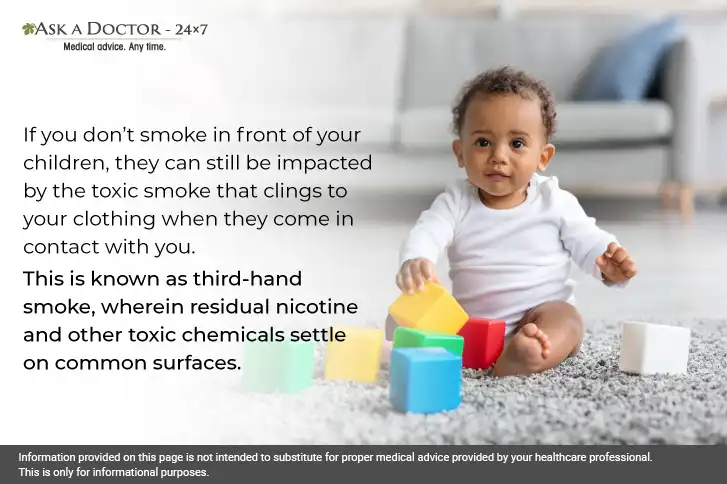How To Protect Children From Tobacco Exposure?
Secondhand smoke, commonly referred to as environmental tobacco smoke, is the smoke exhaled by smokers from the burning tips of cigars, pipes, and cigarettes. There are over 4,000 compounds in it. Over fifty of these chemicals have been linked to cancer, making many of them hazardous. Children are exposed to these substances whenever they breathe in secondhand smoke. Your children can be more vulnerable than you think if you smoke around them or if they are exposed to secondhand smoke elsewhere.
Children's health can be particularly harmed by secondhand smoke because their lungs are still maturing. Even children whose parents smoke outside are still at risk from residual smoke's toxins. Quitting is the best approach to remove this exposure. Let’s understand the ways we can create a smoke-free environment for our children.
Effects of Smoking on Your Children’s Health

Your unborn child is also exposed to dangerous substances if you smoke or are around secondhand smoke when you are pregnant. Numerous major health issues could result from this, such as:
- Miscarriage
- Premature birth (birth with incomplete development)
- Lower birth weight, which could indicate a less healthy infant
- Sudden infant death syndrome (SIDS)
- Attention-deficit/hyperactivity disorder (ADHD) and other learning difficulties
Further to above, children exposed to secondhand smoke may also experience:
- Infections of the ears
- Colds and coughs
- Respiratory issues, including pneumonia and bronchitis
- Tooth caries and bad breath
Long-Term Effects of Secondhand Smoke
Children of parents who smoke are at a higher risk of becoming smokers themselves. Adolescents and children who smoke experience the same health issues as adults. Children exposed to secondhand smoke may experience issues in the future, such as:
- Inadequate lung development, which prevents their lungs from reaching their maximum size
- Cancer of the lung
- Acquired heart disease
- Eye cataract
How To Protect Children from Tobacco Exposure
Let’s look at the seven ways you can protect your children from tobacco exposure:
1) Make a smoke-free environment around your children
To make no smoke surrounding, bring certain modifications in the surroundings such as:
- In the house: Do not permit anyone to smoke within your home premises. Do not allow friends, family, and babysitters to be around children when smoking.
- In daycare: Verify if smoking is prohibited in the crèche for your child.
- In the school: Make sure the entire school, inside and out, is smoke-free for your child. It should be "No smoking" at all school functions.
- In public places: Pick establishments that don't allow smoking. Prefer restaurants with "no smoking" policies.
- In your vehicle: If there are kids in your car, don't let anyone smoke. The act of rolling down a window does not shield them.
2) Lead by example
Give up smoking right now! If your kids witness you smoking, they can be inspired to give it a try and end up becoming smokers too. Children are more likely to try smoking if there are cigarettes available in the house, which is the first step towards addiction.
3) Discuss with your child the advantages of abstaining from tobacco use
Describe to your kids the dangers and addiction of smoking cigarettes. Tell them how smoking increases the risk of developing chronic diseases like heart disease and lung cancer. If friends make fun of them for not smoking, teach them how to resist peer pressure.
4) Get rid of all ashtrays in your home
Removing ashtrays and lighters not only helps remove the trigger to smoke but also prevents third-hand smoke. Children could easily pick up a remnant cigarette butt from an ashtray and predispose themselves to nicotine and chemicals.
5) Stock up on items that could help resist smoking urges
If you or a family member smokes, then start stocking up on items to prevent the urge, like:
- Wholesome snacks such as raw veggies and fruit.
- Sugar-free gums
- Nicotine replacement lozenges or gum.
- Games or puzzles.
- Books that you've been meaning to peruse.
6) Counselling interventions
Counselling an adolescent can help counter attitudes, beliefs, and knowledge regarding smoking, particularly when these are erroneously impacted by social or environmental factors like tobacco marketing or peer pressure.
Interventions in counselling can take many different forms, such as:
- Face-to-face interactions
- Conversations over the phone with a medical professional
- Delivering printed goods via email, mail, or in person
- Internet resources
7) Use a vacuum cleaner with a HEPA filter
A vacuum cleaner with a HEPA filter can help reduce the risks of cigarette smoke by trapping harmful particles from the air. HEPA filters help to remove cigarette smoke residue from surfaces, which can help carpets, walls, and furniture last longer.
Conclusion
Hence, babies and young children are at the greatest risk of exposure to secondhand or third-hand smoke. The best way to prevent this is to make sure your home and vehicle are smoke-free. This includes refraining from using e-cigarettes, cannabis, or tobacco products when your child is present in your house or elsewhere. This should also be implemented in childcare facilities, lodging facilities, dining establishments, hotels, and at the homes of friends and relatives. Talk to your child about the benefits of staying tobacco-free, and set a good example by quitting smoking. If you or a family member has difficulty quitting, you can consult your healthcare provider, who can prepare you for withdrawal symptoms.
You can Ask a Cardiologist at Ask a Doctor, 24x7 and discuss related to tobacco misuse and its effect on children. You can also seek help for tobacco cessation and consult an online Addiction Medicine Specialist.
Recently Answered Questions Related to Tobacco-Associated Health Issues
- What Are The Harmful Effects Of Smoking?
- What Factors Can Increase The Risk of Getting A Heart Attack?
- If a Major Number Of Persons Are Smoking And Few Do Not, Will It Affect The Person By Causing High-Level Intoxication?
- Pregnant, Having Continuous Cough, Mucus With Greyish String. Had Dusted The House, Done Passive Smoking. Worrisome?
- Suffer From Nausea, Headache, Appetite Loss And Dots On The Tongue. Have Smoking And Tobacco Addiction. Help?
- Is Passive Smoking Harmful?
- How Can Asthma Caused By Passive Smoking Be Treated?
- Does Secondhand Smoke Affect One's Final Height?
- How Long Does Nicotine Stay In The System?
Disclaimer: Information provided on this page is not intended to substitute for proper medical advice provided by your healthcare professional. This is only for informational purposes.
Ask a Specialist
Recent Questions


